The Ultimate Guide to Nightclub Photography
Welcome!
You just found the ultimate guide to nightclub photography! Are you ready to take your nightclub photography skills to the next level?
The ultimate guide to nightclub photography will serve as your quick reference, cheat sheet, and resource for all the things that a nightclub photographer should know. It will show you how to make your nightclub and nightlife pictures look awesome! It will teach you nightclub photography techniques that will make your work stand above the rest.
Nightclub photography is about capturing the excitement of the nightlife and the adventures in the party scene. The photos show the guests having a great time and amazing photos enable the viewer to share that experience.
In this guide you will learn:
- the camera equipment needed
- the camera and exposure settings you will use
- flash settings
- what to capture in the nightlife
- and advanced shooting techniques to help you achieve amazing professional results.
Who am I?
I am a freelance Nightclub Photographer who tells a story with my photos. I have photographed events at some of the hottest nightclubs and venues. You can read more about me and my gear.
Camera Equipment for Nightclub Photography
Remember that good photography doesn't necessarily depend on the best and most expensive camera equipment, but the photographer behind the camera. Better equipment helps get great results easier when it's in the right hands.
Digital SLR
A high end point and shoot even the ones that have a hot shoe to attach a flash unit is not adequate for nightclub photography. You need to have at least an entry level digital SLR. Digital SLRs can focus faster and shoot faster with the press of the shutter button. If you have to choose between getting a better DSLR camera body or a better lens, get the entry level DSLR and buy a better lens. Entry level DSLRs are quite affordable and packed with features these days.
Zoom Lens
Use a zoom lens because your lens needs the flexibility to shoot wide shots of big groups and close up shots of one person in a nightclub environment. Nightclubs can get really packed and there may be not much room for you to move if you're using a prime lens. The ideal lens for nightclub photography is a fast (f/2.8) zoom lens in the 17-50mm focal length for a cropped camera body.
External Flash
The built in pop-up flash in your DSLR is not good enough for nightclub photography. Avoid using it at all cost! Get an external flash unit that has a flash head that can tilt and swivel so that you can can bounce the flash off the ceiling or walls.
Memory Cards
Memory cards are pretty cheap these days too. Make sure you have enough when you're shooting.
Extra batteries for the camera and flash
This is pretty self explanatory. You should have extra batteries because you can't shoot if you can't turn on your equipment. My favorite batteries to use for the external flash is the Eneloop AA Ni-MH rechargeable batteries.
Recommended Gear
Camera Body
Lens
Flash
Accessories
- Black Rapid Strap
- Hakuba lens pen
- Sto-fen Omnibounce diffuser
- Eneloop AA Ni-MH rechargeable batteries
I normally don't shoot using a filter, but I do in nightclubs. I would much rather clean the filter with a napkin than clean the front element of an expensive lens with just a napkin. Use a filter and a lens hood when shooting in nightclubs to protect your lens.
The Sto-Fen Omnibounce is a small, versatile, lightweight, and very affordable flash diffuser.
Camera and Exposure Settings for Nightclub Photography
My assumption here is that you're already familiar with photography and you know how the aperture, shutter speed, ISO, and white balance affect the final image. If not, please read some introduction to digital photography books to get a better understanding and appreciation of how the camera settings work to get the desired final image.
I've figured out the exposures to use to capture certain moods that I want to convey. Listed below are my typical camera settings. Note that these are just guidelines and not rules on how to get proper exposure in a nightclub environment.
Mode: M (Manual)
Shoot using manual mode so that you can control the aperture, shutter speed, and ISO.
Aperture: f/2.8 to f/5.6
Shoot wide open at f/2.8 or at the widest aperture available for your lens when photographing individuals and at f/5.6 for large groups of 3 or more people. Shooting at f/4 works when photographing two people.
Shutter Speed: varies (usually somewhere between 1/2 - 1/40 sec)
It depends on the room lighting and the mood being captured. The shutter speed is usually on the slower side (dragging the shutter) to let more ambient light in. Play around with the aperture and shutter speed settings till you get the results that you like.
Note that these are just guidelines and not rules on how to get proper exposure in a nightclub environment.
Changing the aperture will adjust the flash output on the foreground subject. Changing the shutter speed will let more or less background show in the shot. -Popular Photography
ISO: 800 - 1600
You only really have to worry about noise if you don't get a good exposure. Pictures won't have much noise if the exposure is pretty good and consistent. If the pictures are underexposed and you try to fix them later in Photoshop, you'll find that this is when you get a lot of noise.
White Balance: Flash
Nightclubs are typically pretty dark so your external flash unit would probably be the main light source. Having the white balance set to flash would give you accurate colors so that you don't have to spend a lot of time doing color corrections during post processing.
Picture Style Parameters:
Sharpness: +1
Contrast: +1
Saturation: +1
Color Tone: 0
These parameters would reduce the post processing needed on the pictures and they pretty much provide good results straight from the camera.
Flash Settings for Nightclub Photography
External Flash Unit: TTL
Instead of using flash exposure compensation, use rear/2nd curtain sync if your flash/camera body is capable of doing it. The results you'd get would be different and much better than from using 1st curtain sync.
Capturing the Nightlife
Composing the picture in nightclub photography can be challenging because you've got to keep in mind all the stuff happening in the background. It's also harder to see what's in the viewfinder because it can be very dark. It's common to get some out of focus shots here and there because the auto focus was hunting in the low light.
The biggest challenge is figuring out how to get the best light possible especially when the club is dark. You have to be able to "see the light" and think on your feet quickly. Follow the light to capture the party of the nightlife.
Focus on capturing the fun of the nightlife.
Here's a list of a few things to photograph in a nightclub and some sample nightclub pictures to give you a better idea.
- Candid pictures of people dancing
- Bartenders shaking and pouring drinks
- People taking shots, having fun, laughing and smiling
- DJs jamming while they're mixing
- Posed pictures of groups of three or more
- Posed pictures of couples
- Portraits of beautiful women








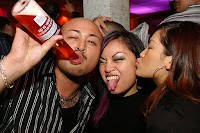



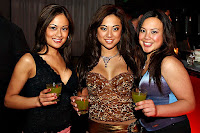

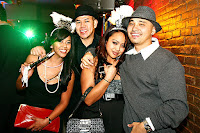




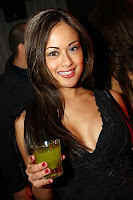



Stay away from:
- Ghetto, trashy, or people that are just way too drunk
- Anyone making disrespectful gestures
Advanced Shooting Techniques for Nightclub Photography
- Pay attention to the light.
- Simplify the composition.
- Use the rule of thirds.
- Vary the angle.
I'm going to provide tips on how to shoot amazing nightclub pictures and some examples with the settings I used.
- Pay attention to the light; make sure that there is some light behind your subject
- Drag the shutter, use 2nd/rear curtain sync on your flash, and move the camera around
- Bounce the flash off the ceiling or wall at various angles when shooting with the flash on the camera
- Shoot with the flash off the camera
- Play around with the aperture and shutter speed settings till you get the results that you like
You should position yourself so that the light is behind the subject. Use a slow shutter speed and set your flash to 2nd or rear curtain sync. The flash will illuminate the subject while you're capturing colorful backgrounds from the ambient lighting.
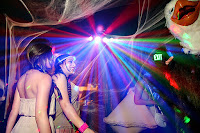
|
Aperture: f/4 Shutter speed: 1/3 sec ISO: 800 |
Dragging the shutter means having a slower shutter speed to let more ambient light in. You would get some interesting light trails by moving the camera around: left to right, right to left, up down, clockwise, counter clockwise, rotate the camera from portrait to landscape, zoom the lens in/out, etc.
Turn pictures like this:
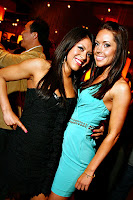
|
Aperture: f/3.5 Shutter speed: 1/5 sec ISO: 800 |
Into this:

|
Aperture: f/3.5 Shutter speed: 1/5 sec ISO: 800 |
As you can see, the camera settings were the same. The pictures were taken just seconds apart. The only difference is that I rotated my camera from portrait to landscape to create a more interesting background. The slow shutter speed let me capture the light behind the subject as I rotated the camera. The flash froze the subject in place.
The room was pretty dark except for some rotating DJ lights. However, there was a disco ball hanging on the ceiling. This was a great opportunity to bounce the flash off the ceiling and hit the disco ball to light up the room.
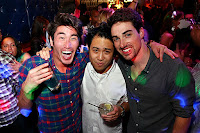
I've used a Canon Speedlite 430EX II Flash and a Canon STE2 Speedlite Transmitter to shoot with the flash off the camera when doing nightclub photography.
The Canon STE2 Speedlite Transmitter is a wireless flash controller for the Canon 430EX II. It goes on the camera body's hot shoe where the external flash unit would normally go. This means that I'm free to hold or put my flash anywhere as long as the transmitter and the flash are within range of each other and not obstructed by anything that would prevent them from communicating with each other. I find that this technique is more versatile than using a bracket.
Hold the flash with your left hand and position it at different angles when shooting with the flash off the camera. The flash is pointed directly at the subject and not bounced off the ceiling or wall. By the way, the flash is on slave mode.
Shooting with the flash off the camera would allow you to create more dramatic lighting. Vary the angle, simplify the composition, and allow the subject to pop out by controlling the light.

The best way to learn is by doing. You would get to see the results right away on the LCD of your digital SLR. If it doesn't turn out the way you had imagined, change the shutter speed and try again.
Nightclub Photography Cheat Sheet
Here is a summary of the ultimate guide to nightclub photography that can be used as your cheat sheet or quick reference.
Nightclub Photography Camera Gear
- Digital SLR - do not use a point and shoot camera
- Zoom Lens - 17-50mm f/2.8
- External Flash - do not use the built in pop-up flash in your DSLR
Nightclub Photography Camera Settings
- Mode: M (Manual)
- Aperture: f/2.8 to f/5.6
- Shutter Speed: between 1/2 - 1/40 sec
- ISO: 800 - 1600
- White Balance: Flash
- Picture Style Parameters: Sharpness: +1, Contrast: +1, Saturation: +1, Color Tone: 0
- External Flash Unit: TTL, rear/2nd curtain sync
Capture the Fun of the Nightlife
- Candid pictures of people dancing
- Bartenders shaking and pouring drinks
- People taking shots, having fun, laughing and smiling
- DJs jamming while they're mixing
- Posed pictures of groups of three or more
- Posed pictures of couples
- Pictures of good looking people
Advanced Nightclub Photography Shooting Techniques
- Pay attention to the light; make sure that there is some light behind your subject
- Drag the shutter, use 2nd/rear curtain sync on your flash, and move the camera around
- Bounce the flash off the ceiling or wall at various angles when shooting with the flash on the camera
- Shoot with the flash off the camera
- Play around with the aperture and shutter speed settings till you get the results that you like
Party on!
nightclubphotographer.blogspot.com is a participant in the Amazon Services LLC Associates Program, an affiliate advertising program designed to provide a means for sites to earn advertising fees by advertising and linking to amazon.com. Clicking these links won’t cost you any extra money. I appreciate your support.
